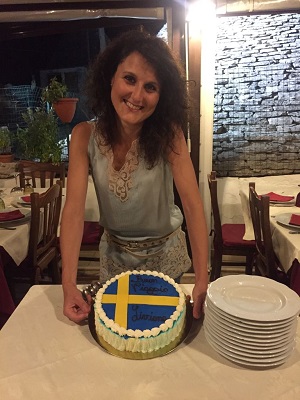Interview with Liviana Palmisano
Liviana Palmisano, recently appointed as an associate professor in mathematics with a specialization in mathematical analysis, speaks to us about her work, career and plans.

Hello Liviana, tell us a little bit about you, your academic background, where you come from, etc.?
My name is Liviana and I am associate professor in the department of mathematics at KTH. I was born in Italy, where I did most of my studies. For the last year of master and later, for the PhD, I moved to France. I defended my PhD thesis in December 2013 at the University of Paris XI. In January 2014 the postdoc journey began. First Warsaw, then Bristol and later Uppsala. In these years I did travel a lot for conferences, seminars and visiting positions. In January 2020 the permanent job finally came. I moved to the University of Durham, UK, as assistant professor, where I stayed until this last January, when I joined KTH.
Taking up a new position is a challenge on its own. How has your time as an associate professor been so far, any significant changes compared to your previous position?
Difficult to answer this question. I started only 2 months ago. Surely this position comes with more responsibilities compared to my previous one.
Tell us about your research; what makes it important?
I work in the field of dynamical systems. My work is related to the study of fractals. In the last decades, mathematicians realized that forms in nature are far more complicated than the objects studied in classical geometry. Fractals are often a good approximation of nature. However, they can be very difficult to study. One part of my research is concentrated on understanding properties of certain fractals arising in low dynamical systems. The theory of chaos plays a major role in my field of study.
Does your work have practical applications? If so, what would those be?
Dynamical systems are closely related to differential equations which most of the time describe nature-related phenomena. For example in meteorology, astronomy, chemistry, etc. One could then claim that the field of dynamical systems has many applications. Moreover, the real truth is that phenomena observed in nature are too complicated and we generally study much simpler problems. When we prove a theorem we do not pretend or necessarily see a straight forward application and generally this is not our aim either.
What made you interested in your field?
The main reason for which I study math is beauty. I have always been sensitive to beauty and I find its ultimate form in math. I especially like the field of dynamical systems because the tools used are a mix of geometry, probability, analysis, etc. In other words, many different branches of math converge together.
Is it important for you to communicate your research to the world? If yes, why and how do you do that?
The simplest way to communicate my work it is by giving lectures in seminars or conferences. Explaining very deep mathematical concepts and ideas can be very difficult, But also very rewarding. I think that we, as mathematicians and scientist in general, have the duty to try to communicate our knowledge and do not let it sit in our laboratories or offices.
What would be your message or advice to youngsters interested in pursuing scientific professions?
Follow your passion and do not be scared by the difficulties. Everything in life can be achieved with a lot of work and determination. In my carreer, I have met many people, women and men with different backgrounds and stories. They all had different priorities and wishes in life, and they all made them possible.
Text: Elina Charatsidou
